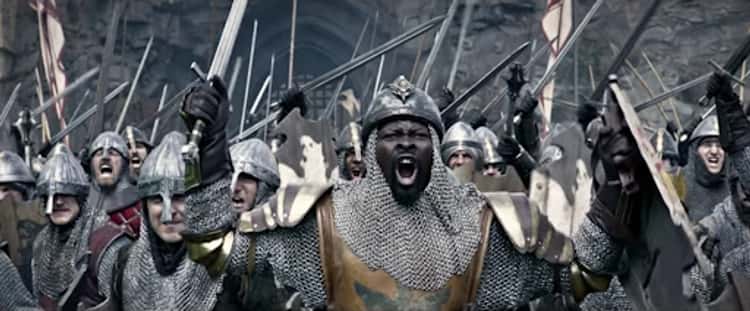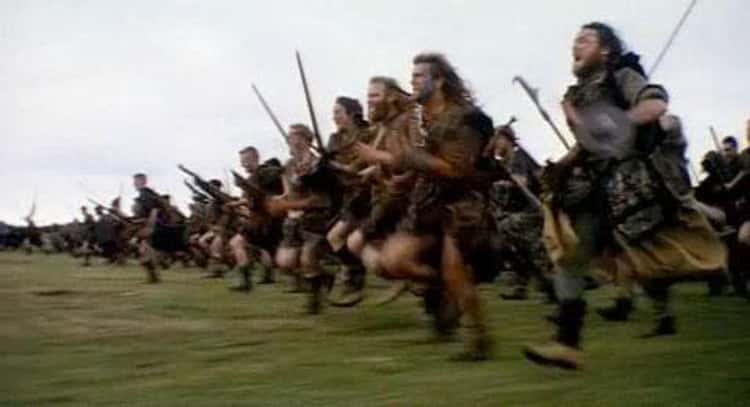Hollywood has taken us to medieval battlefields for as long as it’s been making movies. But while medieval warfare movies are definitely exciting, most of them are far from realistic.
When you’re talking about battles that took place hundreds of years ago, the average person has no real way of relating to them without extensive research. History consultants are sometimes hired to help accurately portray the Middle Ages in film, but filmmakers never allow the experts to get in the way of a good story. That’s how you end up with a medieval commander ordering their archers to attack by shouting “Fire!” – even though fire is nowhere near the battlefield!
Thanks to movies, most of us have no idea how medieval battles really worked. Today, we’re going to revisit some of the misconceptions of medievalism in popular culture, and explore what ancient warfare was really like. Here are some of the dumbest things we believe about medieval warfare thanks to movies.
1. Being Struck By An Arrow Wasn’t A Big Deal

The best way to show the audience that a movie character is Built Ford Tough is to show them getting hit by an arrow and shrugging it off. In Braveheart for example, William Wallace takes an arrow literally to the heart. But it only slows him down for a moment. He breaks off the arrow shaft and keeps fighting. Other movie characters might just pull out the arrow entirely.
Even as late as the 19th century, military surgeons considered arrow wounds to be among the most fatal. Arrows are specifically designed to get stuck in the body and be incredibly painful and difficult to remove. Triangular arrowheads often had barbs that tore the flesh on the way out.
Arrows are difficult for medical professionals to remove, and doing it yourself would have been incredibly painful. Assuming the arrow didn’t break any of your bones or damage your organs, you would then be at risk of infection. Either way, an arrow wound is going to ruin your day.
2. Sword Fighting Was Like A Lethal Form Of Break Dancing

When two characters fight one-on-one with swords (which would be unlikely to happen on a battlefield anyway), it often resembles an elaborately choreographed dance routine. A typical movie sword fighter might use backflips, somersaults, spin moves, and other kinds of fancy footwork. And if they can toss off a few clever quips, even better.
That type of sword fighting is really a form of 19th-century aristocratic dueling. Medieval sword fighting was a lot more brutal. Hundreds of sword fighting training manuals from the Middle Ages have survived to the present. These manuals advise fighters to win at all costs, including many techniques that might be considered unchivalrous. They typically encourage medieval sword fighters to act quickly and aggressively, and to attack an opponent’s weak spots in order to immobilize them and finish them off.
In a real battle, doing a spin move would have been particularly dangerous, because it leaves your back exposed to the enemy (unless they’re also doing a spin move at the same time).
3. You Can Just Stab Through Armor

If movies and TV shows are all you have to go on, armor in the Middle Ages was next to useless. Onscreen, a skilled medieval warrior can slice through their opponents with a sword, even if those opponents are wearing full plate armor. Watching enough scenes might make you wonder why everyone spent so much time and money building armor if it provides as much protection as cardboard.
To be fair to Hollywood, medieval art does occasionally depict swordsmen stabbing each other through the armor. But this often occurs in training manuals designed to demonstrate sword fighting technique, not literal events.
First, let’s be clear about which kind of armor we’re talking about. Chain mail from the early medieval period was susceptible to puncturing from sharp weapons, but plate armor, which covers most or all of the body in steel, was specifically designed to offer more protection than chain mail. Swords and longswords could not punch through steel plate armor.
But plate armor didn’t make the wearer invulnerable, either. In the later medieval period, knights began carrying long knives called rondel daggers, which they used to stab enemies in the gaps of their armor. And plate armor only protects from piercing damage, not blunt-force trauma. A heavy weapon like a mace, club, or warhammer could still easily smash and incapacitate an armored opponent.
4. Everyone Used Swords (Aside From Maybe One Special Axe Guy)

Sword fights are inherently cinematic. Onscreen, medieval warfare often boils down to thousands of individual sword fights. Not only does every combatant wield either a sword or a longsword, when the fighting starts, everyone pairs up with an enemy and clangs their swords together until one of them gets the advantage. Win enough one-on-one fights and you win the battle.
The truth is, swords are wildly over-represented in movies and TV shows. In the early Middle Ages (the seventh to ninth centuries), swords were expensive to make and usually only available to the wealthiest fighters. Eventually, sword-making techniques advanced and they became more common, but they were still only one of many weapons available.
Medieval weapons were made for specific purposes. Swords are great for up-close fighting, but spears, pikes, and halberds offer much more reach. Swords can pierce and slash, which is useful against an unarmored or chain-mailed opponent, but ineffective against plate armor. In that case, you’d want a mace, morning star, war hammer, or another bludgeoning weapon. Medieval armies typically used all of the above weapons and more.
5. Cavalry Charged Straight Into Infantry At Full Speed

The cavalry charge is a movie’s bread and butter. A mob of heavily armored knights gallops directly into a wall of spears and pikes, and mayhem ensues. But there are several problems with this notion. First, the speed. The faster the horse gallops, the more force is behind the knight’s attack. But all that forward momentum would also send a knight flying into the back of their horse’s head when they hit an obstruction.
Second, the tactics. If a group of mounted knights was going to attack infantry, they typically would only attack after the infantry started to flee the battlefield. Riding full-tilt at a motivated and well-fortified infantry, who are probably holding spears and pikes, would have been idiotic.
Instead, knights had many alternate ways to attack. Real cavalry could often start with a frontal charge and then make a turn just before hitting the enemy. They could dismount and engage the enemy on foot. They could use ranged weapons. Or they could try to encircle the enemy and gradually close in on them.
Of course, the biggest issue with this trope is the horses themselves. Even horses bred for war still want to survive, and few can be convinced to gallop directly into a sharp object.
6. Helmets Were Optional

Stepping onto a medieval battlefield, or any battlefield, without a helmet makes about as much sense as stepping onto an American football field without a helmet. Yet in so many medieval battle scenes, the heroes and villains do battle bareheaded – even if everyone else around them is wearing protective headgear.
The reason movies and TV shows do this is because, well, the stars’ faces need to be visible. But in reality, helmets were an essential part of every soldier’s kit, even the poorest ones. Since armor covered the torso, the opponent’s head was the most vulnerable target on their body.
Archaeological excavations of medieval battlefields reveal that soldiers most commonly targeted the heads or the legs. For example, skeletal remains from the Battle of Towton, fought during the Wars of the Roses, revealed that most of the deceased had multiple, severe head wounds. And there were zero chest wounds.
7. Two Armies Just Ran Towards And Then Smashed Into One Another

Most medieval battle scenes start the same way. Two sides have massed their armies on opposite sides of the battlefield. The commanders give the order, and both sides charge full-speed into each other. They meet in a chaotic melee where it’s nearly impossible to tell ally from enemy.
However, if military commanders really ordered their armies to attack in this way, they wouldn’t hold onto their jobs for long. Throwing your soldiers into a wall of enemy soldiers without thinking is both ineffective and costly.
For most of the last few thousand years, warfare has been waged using overarching strategies and on-the-ground tactics, not chaotic free-for-alls. Even the armies themselves are more complex than just throwing a bunch of soldiers into a mob. Today, multiple units are employed with different specialties to achieve goals that a mass of soldiers never could – and the Middle Ages were no different. Depending on the army, medieval commanders could use light and heavy cavalry, spearmen and pikemen, archers and crossbowmen, and both professional infantry as well as unskilled militia.
Infantry also wasn’t just a mob of guys with swords. Medieval infantry was divided into several different units and sub-units, and every soldier needed to follow their group leader in order for the whole to operate effectively.
8. Knights’ Armor Was So Heavy They Could Barely Stand

At first glance, wrapping yourself in metal to survive a battle seems like a risky tradeoff: You’ll gain extra protection, but at the cost of your mobility. Movies and TV shows act as if a knight’s armor is as cumbersome as a diving bell. Before the battle, a knight often needs help mounting their horse, or even a special crane. During the battle itself, if a knight falls to the ground, there’s no way they can get back up under their own power. Basically a knight would have to be as strong as Hafþór Björnsson or else it was game over.
But if actual armor really was this impractical, medieval warriors wouldn’t have bothered. Early medieval warriors often wore chain mail that weighed around 30 pounds. Later medieval plate armor, which fully encased the knight, typically weighed between 45 and 55 pounds. Furthermore, all of this weight was evenly distributed around the body. By contrast, modern American infantry are expected to carry up to 100 pounds of gear on a daily basis, and 152 pounds over a distance of nine miles.
This trope probably originated as a joke in Mark Twain’s A Connecticut Yankee in King Arthur’s Court, and was solidified in Sir Laurence Olivier’s 1944 film Henry V.
9. Once You Breach The Castle Walls, A Siege Is Over

On paper, castle sieges have all the ingredients for a great battle scene. The invading army faces seemingly impenetrable defenses and has to throw away countless lives to breach them. On the defending side, the stakes couldn’t be higher: Turn back the enemy or perish. Most of these siege battle scenes, like the Battle of Helm’s Deep in The Two Towers, hinge on whether the attacking enemy can break through the castle walls. Once that happens, it’s all over (barring a miraculous rescue by a wizard).
But real siege battles weren’t so simple. Most later stone castles in the medieval period were actually the center of a sprawling town that had its own defensive walls. If an attacking army could breach the town’s outer walls, the defenders would simply retreat to the castle, which often had even more fortified walls.
Medieval armies had many techniques to go over, around, through, or even under castle walls. But a frontal assault was usually an attacking army’s last resort. Instead, attacking medieval armies tried to negotiate with the castle defenders for a peaceful surrender. If that didn’t work, the next option was to starve them out.
